
Day 1: Entry City>>>High speed Rail>>>Ganzhou>>>Songcheng Ancient City>>>Qili Ancient Town
Depart at the designated time and location based on the ticket number, and take the reference train from Shenzhen North Station to Jiangxi.
Reference train number: Take the G2776 high-speed train (10:35/12:52) or G2694 high-speed train (11:41/14:14) or other trains to Ganzhou high-speed railway station.
Embark on a tour of the scenery of Song City: The famous Jiangnan building, Yugutai (built during the Guangde to Dali period of the Tang Dynasty. It is known as the Yugutai due to its unique style of “crowning a county, but carrying a thousand miles of rivers and mountains”, and the desolate and isolated Longfu. Due to the ancient masterpiece left by the famous poet Xin Qiji of the Southern Song Dynasty, “the green mountains cannot cover it, after all, it flows eastward”, celebrities and scholars linger to visit the former residence of Jiang Jingguo (Jiang Jingguo came to Gannan in 1940, serving as the Inspector General of the Fourth Administrative Region of Jiangxi and the County Magistrate of Gan County. During his six years in Gan, his family lived here to observe the longest preserved Jiangnan). The most intact ancient city walls, Eight Realms Terrace, and Ancient Floating Bridge of the Song Dynasty (built during the Jiayou period of the Northern Song Dynasty) were named and famous for the Eight Realms of Qianzhou by the county governor Kong Zonghan and Su Shi’s Eight Scenic Poems, making them the birthplace of the Eight Scenic Culture. Looking into the distance from the stage, one can see blue waves and white sails, green trees and red buildings, and the river breeze rushing towards them, making one feel relaxed and happy,
Afterwards, head to the Qili Ancient Town Scenic Area, which is the largest immersive Chinese style town in the country, covering an area of approximately 480000 square meters. The ancient town deeply excavates the historical and cultural heritage of Gannan, refines the traditional elements of beam transportation culture, temple fair culture, and integrates spiritual places such as ancient trees, houses, and alleys, and reproduces the bustling and prosperous scene of the former economic center. Among them, there are three functional sections and five themed vacation hotels.
The Water Music Light and Shadow Show of Zhentou Lake’s “Immortal Village: All Things Have Spirits” takes about 10 minutes to interpret, combining two chapters of playing with immortals and nourishing all things, integrating cute pets and hotel formats, and outlining a beautiful light and shadow kingdom. And use “flora and fauna”, “national style”
The keywords “childlike fun” and “dreamy and lively” perfectly present “Immortal Village: Spiritual Everything” to satisfy urban people’s beautiful imagination of nature. In terms of content, “Xianling Village: All Things Have Spirits” showcases a mysterious water area emitting dreamy radiance to tourists, with rare animals appearing and disappearing in the water curtain. In the flowing and colorful atmosphere created by the top domestic high-tech laser holographic projection, misty forest, ambient light and shadow, and music fountain methods, tourists will feel the colorful and vibrant vitality of Xianling Village; Using imagery techniques, the good luck and blessings that bless the Xianling Village are transformed into unpredictable light and shadow, with a focus on creating a joyful, warm, and romantic dreamy night show along the coast.
The Light and Shadow Performance Show of Wenchang Pavilion: The 15 minute light and shadow show combines four major chapters, using culture as a guide to perfectly present the light and shadow of ancient architecture. Based on the life of the top scorer in Enke, Chi Mengli, and using the architecture of Wenchang Pavilion as a carrier, “Luck in Wenchang” is created. With the help of high-tech cutting-edge sound, light, and electrical technology, as well as internationally renowned 3D projection technology, combined with professional performance art, we have outlined four combined arts: “Wen Qu Descends to Earth to Show the Heavenly Phenomenon”, “Cold Window Bitter Reading Newspapers for Home and Country”, “Top Scholar Leaps Over the Dragon Gate”, and “Talents and Earthly Spiritual Illumination of Ancient and Modern Times”
The world of light and shadow with infectious power. By combining drone arrays to create a brilliant Milky Way, the night sky of Wenchang Pavilion is illuminated, and a dreamy show intertwined with time is performed with splendid dance steps. The Light and Shadow Show is located in the “Rumengli” commercial experience block, characterized by “strong playability” and “immersive”, enhancing the empathy and interaction of tourists, allowing them to not only experience light and shadow, but also feel good luck and blessings, thus bringing tourists a multi-dimensional amusement experience.
The large-scale live performance of Shuiji’s “Millennium Hakka” combines the history and culture of Qili Ancient Town to explore the unique charm of the Hakka culture in Qili Ancient Town. The performance utilizes a variety of artistic and technological expressions, extracting various artistic elements from the natural landscape, history, and culture of Qili Ancient Town. It utilizes various high-tech means such as international first-class cutting-edge stage design, six over 40000 lumen holographic projection, a 100 meter wide fountain water screen, and international first-class stage lighting, sound, and cold fireworks, presenting a new, unique, unique, and beautiful cultural feast with a high-tech sense. The entire drama takes about 45 minutes to complete, with the six major migrations of Hakka people as the theme and the scattered legendary stories in Qili Town as the latitude. It is connected by a Hakka girl returning from overseas on a journey to find her roots, weaving and interpreting a clear historical context and a unique Hakka dream chasing journey for tourists and audiences. It is divided into five chapters, starting from the story of Emperor Qin Shi Huang sending woodcutters to Gannan to chop wood, tracing the continuous migration of the Hakka people for thousands of years. Describing the development and origin of the wooden raft trade and the prosperity of the kiln craftsmanship and porcelain industry, Hakka people have gradually grown from small saplings to towering trees, and have become cultural treasures that cannot be ignored in Chinese culture since history. Finally, they left Ganzhou and went global, creating a prosperous era for the Hakka people.
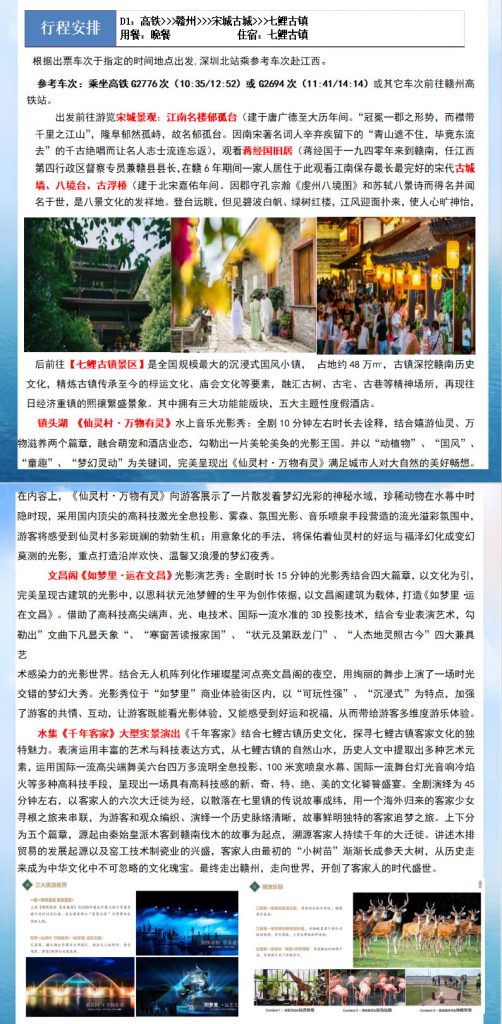
Day 2: Wei Family Courtyard>>Fushou Gully>>Yudu Long March First Ferry Crossing>>Ruijin
After breakfast, the Weijia Courtyard is a folk house built in succession from the mid Qing Dynasty to the early Republic of China. It is the largest existing Hakka house of the Qing Dynasty in Ganzhou and even in the urban area of the province. It embodies the typical format of traditional buildings in southern Jiangxi, is a valuable family building group with rich cultural connotation in southern Jiangxi, and is the essence of ancient buildings in Ganzhou.
The Fushou Gully in the back view utilizes the elevation difference of the terrain to connect the urban pond water system for flood storage, leading to the water window at the city wall. A one-way water window is used to block the flood of the Gan River, and when the flood subsides, it is discharged into the Gan River. Fushou Gou has been used for thousands of years and is a typical living cultural relic. It is still the main component of the drainage system in the old urban area of Ganzhou to this day. The total length of the original canal is not less than 12.6 kilometers, and at least 1.9 kilometers still retain the ancient form and materials. The surveyed section from Junjing Lane to Yaoyaqian and Luojia Lane, consisting of two historical original ditch sections, has a total length of 1066.4 meters for the main ditch and 37.5 meters for the branch ditch. The main trench is a 0.7-1 meter wide and 1.1-1.35 meter high pipe trench, with a blue brick arch top, brick and stone side walls, and a flat bottom. Well preserved, original structure preserved, with rich historical information superimposed, still functional. Fushou Gou has undergone updates and evolution over the ages, leaving behind rich physical relics and historical information. It is a living witness to the thousand year history of Ganzhou, the capital of Song Dynasty, and also a valuable empirical data for studying ancient Chinese urban construction.
After lunch, visit the first crossing of the Long March – Yudu Dongmen Ferry,
After visiting the Long March Departure Memorial Hall (closed on Monday, working hours 8-12 pm; 2pm to 4pm), in order to promote the spirit of the Long March and commemorate the achievements of our predecessors, we invested nearly ten million yuan to renovate and expand the Central Red Army Long March First Crossing Memorial Park. It consists of an entrance small square, themed sculptures, assembly square, memorial square, and the Central Red Army Long March Departure Memorial Hall. The display adopts modern means such as text, charts, photos, sound, light, and electricity to visually display the history of the Central Red Army’s departure from the Long March, and to reproduce the great turning point of the Chinese revolution and the historical scene of the Soviet people supporting the Red Army. Take a car to Ruijin, after dinner, check into the hotel
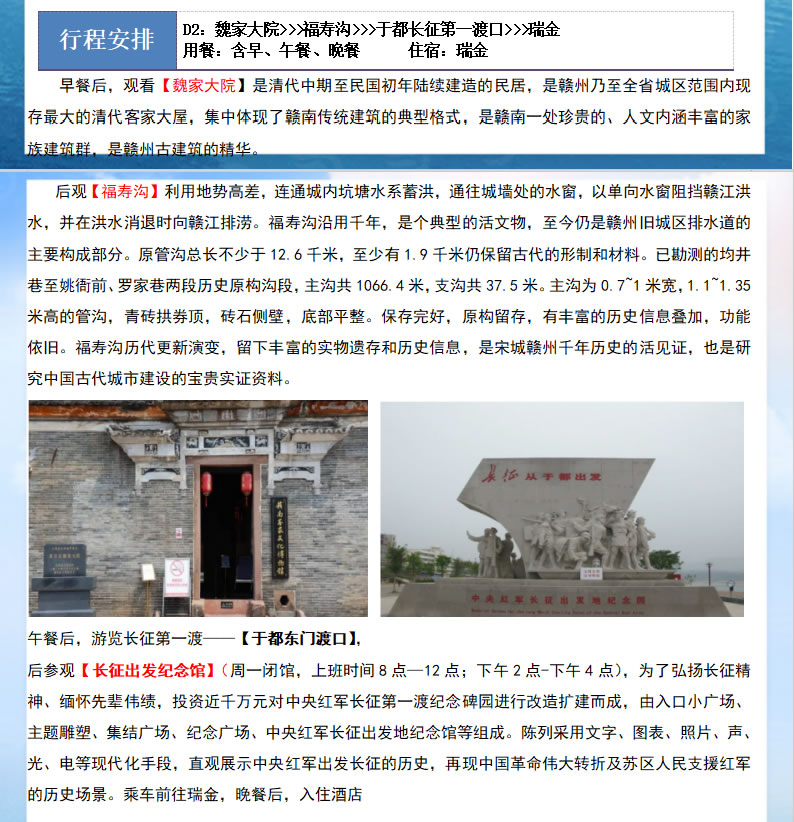
Day 3: Yeping Revolution Site>>Hongjing>>Ruijin Military Commissioner Site>>Longnan
After breakfast, take a car to the Ruijin National 5A Scenic Area – Yeping Revolutionary Site (1.5 hours): the Ruijing warship, the Yisu Exhibition Hall, the Yisu Conference Site, the National Postal Bureau, the National Bank, the Red China News Agency, the Central Bureau of the Communist Party of China’s Soviet Area, Chairman Mao’s former residence, and the Red Army Square, which are five major buildings (about 10000 square meters), serving as a demonstration site.
Shazhouba Revolutionary Site: The former site of the Central Executive Committee, the former site of the Central People’s Committee, the former residence of Chairman Mao, and the “never forget to dig wells while drinking water.”,
“Always Miss Chairman Mao” – “Red Well”; Visit 54 ministries and commissions to establish traditional education bases for seeking roots and ancestors.
Afterwards, take a car to Ruijin to visit the former site of the Second Soviet University. The site of the Second National Congress of the Chinese Soviet Republic, known as the predecessor of the Great Hall of the People, overlooks the shape of the Red Army’s octagonal hat, exuding a magnificent atmosphere!
Visit the former site of the Ruijin Military Commission. The former site of the Central Revolutionary Military Commission of the Chinese Soviet Republic is located in Wushilong Village, Shazhouba, west of Ruijin City. This old site was originally a local Yang’s private temple and was announced as a national key cultural relic protection unit in 1996. On November 25, 1931, the Central Revolutionary Military Commission of the Chinese Soviet Republic (referred to as the “Central Revolutionary Military Commission”) was officially established and stationed at the Liu Clan Ancestral Hall in Yangxi Village, Yeping, Ruijin. The Central Revolutionary Military Commission is not only the highest military leadership and command organ of the Central Soviet Area, but also the highest leadership and command organ of the National Red Army. It is under the jurisdiction of the Provisional Central Government of the Soviet Union in terms of organizational system, but politically accepts the leadership of the Central Committee of the Communist Party of China and the Central Bureau of the Communist Party of China Soviet Area. Military actions and all major decisions are constrained by the Provisional Central Committee of the Communist Party of China in Shanghai.
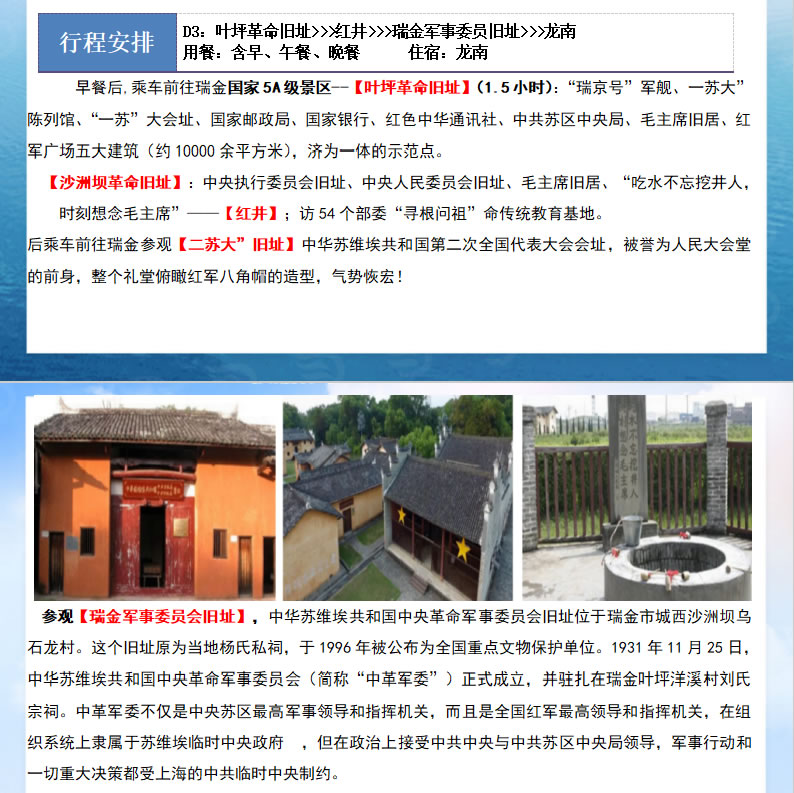
Day 4: Shike City>>Qianxin Town>>Longnan>>Exit Port
After breakfast, head to the World Hakka Folk Culture City as the main venue for the 32nd World Hakka Conference. The project covers an area of approximately 476 acres and has a building area of 215000 square meters. The World Hakka Folk Culture City includes the main venue of the World Hakka Fair, Wushiwei Hotel, Twin Towers, Riverside Villa, Riverside Commercial Street, Pedestrian Bridge, and Riverside Leisure Landscape Park. The functional zoning includes the main venue of the 32nd World Hakka Fair, AAAA scenic area, internet celebrity check-in points, and local citizen leisure center. It has become a new business card of the Longnan City that integrates the experience of Longnan Hakka culture, intangible cultural heritage display, tourism, leisure and entertainment, commerce, night economy, and other functions. The main venue of the World Hakka Fair follows the architectural style of Hakka enclosed houses, and is carefully upgraded and transformed from the original border trade building. The outer perimeter is modeled after the Guanxi New Fen, and the inner courtyard is modeled after the Yanyi Fen, with additional features added. The elements of Hakka walled houses are depicted on the horse tower. The main venue covers an area of approximately 17800 square meters, with the atrium serving as the venue for the opening ceremony and evening party of the World Trade Fair, covering an area of 5700 square meters. The first floor features the Hakka Intangible Cultural Heritage Exhibition, while the second floor features the “Entering Ganzhou” Exhibition and a temporary exhibition hall.
Guanxin Town Resort has an average altitude of 600 meters and is home to 100000 acres of bamboo forest, 10000 acres of organic tea gardens, and up to 110000 negative oxygen ions per cubic meter. Qianxin Town is a family leisure and vacation experience base that integrates natural scenery, pastoral scenery, Hakka customs, and Qiancha culture, with unique ecological organic tea, bamboo forest local chicken, Gannan navel orange, Gannan oil tea and other ecological agricultural industries as the core foundation, and “Qianxin” culture as the theme. It combines rich mountain and water tea and bamboo resources to create a unique family leisure and vacation experience base. It is a tea tourism combined ecological tourism characteristic town. The theme of Qianxin Town is “Qianxin” culture. In ancient times, Ganzhou was known as Qianzhou, and Longnan was known as Qiannan. Taking “Qiannan” expresses the inheritance and development of Hakka culture, which has historical significance. Meanwhile, “Qianxin” in modern Chinese means devout, respectful, and considerate, expressing the concept and pursuit of Qianxin Town’s full score service to customers. The town of Qianxin is just a concept, not a true town. It is a mountainous area that integrates local historical heritage, accumulation, change, and innovation. With unique characteristics as the background, it achieves a certain level of tourism through creativity. Qianxin Town integrates three major elements: natural scenery, pastoral scenery, and Hakka customs, integrating Qianxin tea culture, tourism and sightseeing, leisure and vacation, health and recuperation, business meetings, agricultural and sideline products, traditional craftsmanship, and agricultural experience. If the pure ecological natural and cultural form is the “form” of a small town, then the “devout culture” that runs through it is the “soul” of the town.
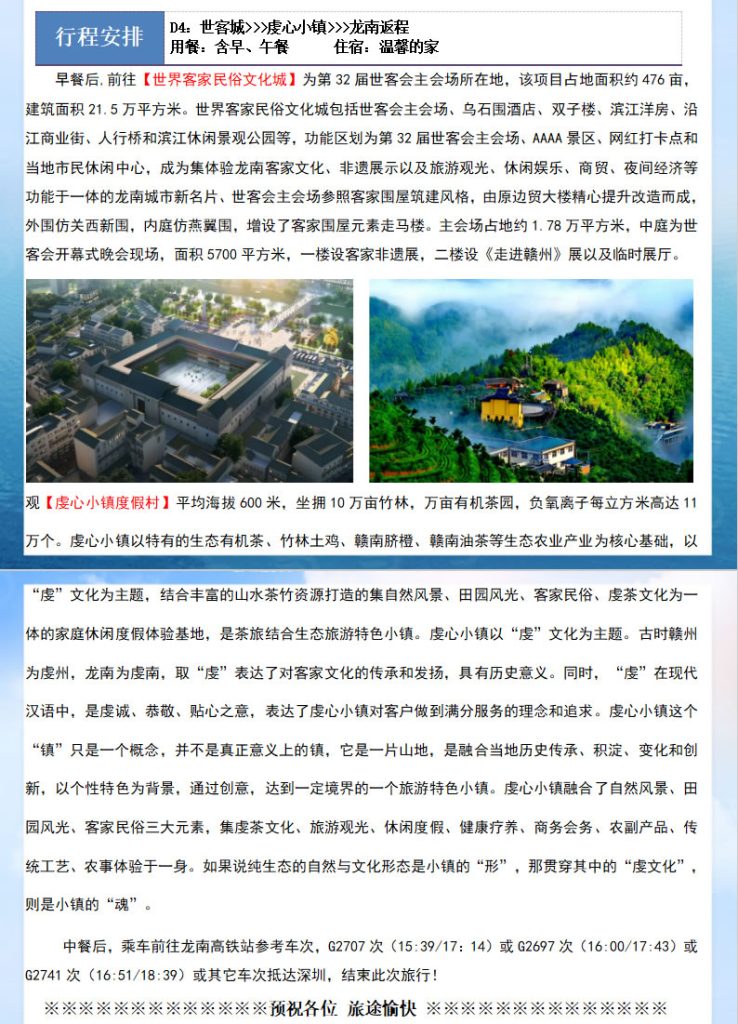
After Chinese cuisine, take a bus to Longnan High speed Railway Station or other trains to the exit port to end this trip!
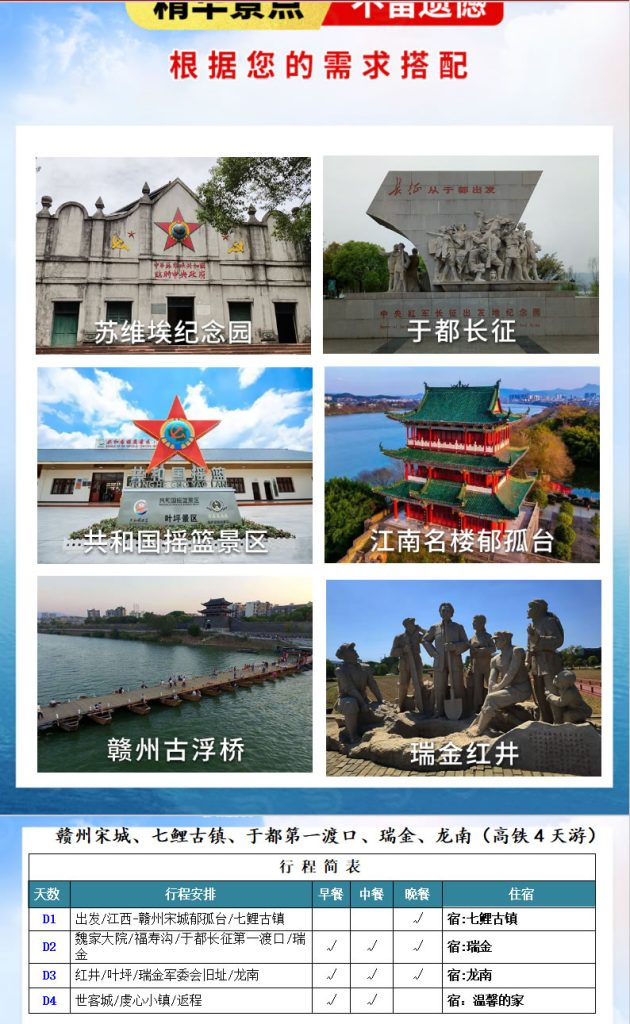
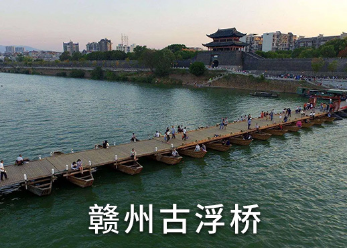
No Responses